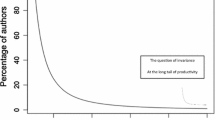Abstract
Focuses on the validity of Lotka's law and the negative binomial distribution model to author productivity data in different time periods in theoretical population genetics speciality. Finds out if there is any relation between applicability of a statistical distribution and the development of speciality. Looks at the linkages between inequality/concentration measures and the development of speciality. Explores the relevance and applicability of the two generalisations, namely Price Square, Root Law and 80/20 Rule to the author productivity data and their relation with development of theoretical population genetics. Finally, a study of the growth of practitioners in the field with different productivity levels is conducted, and the emergence of core authors in the speciality is explored.
Similar content being viewed by others
References
D. De Solla Price,Science since Babylon, New Haven, Connecticut, Yale University Press, 1961.
D. Crane,Invisible Colleges: Diffusion of Knowledge in Scientific Communities, Chicago, The University of Chicago Press, 1972, p 213.
J. D. Sterman, The growth of knowledge: Testing a theory of scientific revolutions with a formal model,Technological Forecasting and Social Change, 28 (1985) 93.
A. J. Lotka, The frequency distribution of scientific productivity,Journal of the Washington Academy of Science, 16 (1926) 317–323.
A. Bookstein, The bibliometric distribution,Library Quarterly, 46 (October 1976), 416–423.
D. K. Gupta, Author productivity patterns: Geoscientific literature of Nigeria for the period 1904–1979,International Conference on Informetrics, August 1993, Bangalore.
D. K. Gupta, Lotka's law and productivity patterns of entomological research in Nigeria for the period 1900–1973,Scientometrics, 12 (1987) 33–46.
D. K. Gupta, Scientometric study of biochemical literature of Nigeria, 1970–1984: Application of Lotka's law and 80/20 rule,Scientometrics, 15 (1989) 171–179.
L. J. Murphy, Lotka's law in the humanities,Journal of the American Society for Information Science, 24 (1973) 461–462.
Ravinder Nath, Wade M. Jackson, Productivity of management information system researchers: Does Lotka's law apply?Information Processing and Management, 27 (2/3) (1991) 203–210.
T. R. Radhakrishnan, R. Kernizan, Lotka's law and computer sicence literature,Journal of the American Society for Information Science, 30 (1979) 51–54.
A. E. Schorr, Lotka's law and history of legal medicine,Research in, Librarianship, 30 (1975) 205–209.
A. E. Schorr, Lotka's law and library Science,Research Quarterly 14 (Fall 1974) 32–33.
A. E. Schorr, Lotka's law and map librarianship,Journal of the American Society for Information Science, 26 (1975) 189–190.
K. Subramanyam, Lotka's law and literature of computer science,IEEE Transactions on Professional Communication, 22 (1979) 187–189.
K. Subramanyam, Lotka's law and library literature,Library Research, 3 (1981) 167–170.
H. Voos, Lotka and information science,Journal of the American Society for Information Science, 25 (1974) 270–272.
Ye-Sho Chen, F. F. Leimkuhler, A relationship between Lotak's law, Bradford's law, and Zipf's law,Journal of the American Society for Information Science, 1986 (September), 307–313.
Ye-Sho Chen, Analysis of Lotka's law: The Simon-Yule approach,Information Processing and Management, 25 (1989) 527–544.
D. Lindsey, Production and citation measures in the sociology of science: The problem of multiple authorship,Social Studies of Science, 10 (1980) 145–162.
D. K. Gupta, Lotka's law and its application to author productivity distribution of psychological literature of Africa for the period 1966–1975. Part 1: Development of Lotka's law,Herald of Library Science, 28 (January–April 1989) 11–21.
P. T. Nicholls, Empirical validation of Lotak's law,Information Processing and Management, 22 (1986) 417–419.
M. L. Pao, Lotka's test,Collection Management, 4 (1982) 111–124.
M. L. Pao, Lotka's law: A testing procedure,Information Processing and Management, 21 (1985) 305–332.
M. A. Kunz, A case study against Haitun's, conjectures,Scientometrics, 13 (1988) 25–33.
S. D. Haitun, On M. Kunz's article “A case study against Haitun's conjectures”,Scientometrics, 13 (1988) 35–44.
A. Schubert, W. Glänzel, A second look at the class of skew distribution,Scientometrics, 6 (1984) 149–167.
J. Felsenstein, Comp.Bibliography of Theoretical Population Genetics, Pennsylvania; Dowen, Hutchenson & Ross, 1981.
J. Vlachy, Variable factors in scientific communities: Observations on Lotka's law,Teorie e Metoda, 4 (1972) 91–120.
I. K. Ravichandra Rao, The distribution of scientific productivity and social change,Journal of the American society for Information Science, 3 (1980) 111–120.
R. C. Coile, Lotka's frequency distribution of scientific productivity,Journal of the American Society for Information Science, 28 (1977) 366–370.
I. K. Ravichandra Rao, Probability distributions and inequality measures for analysis of circulation data. In:L. Egghe, R. Rousseau (Eds),Informetrics 87/88 Amsterdam, Elsevier 1988, pp. 231–248.
S. Kyvik, Productivity differences field of learning, and Lotka's law,Scientometrics, 15 (1989) 205–214.
M. P. Carpenter, Similarity of Pratt's measure of class concentration to the Gini Index,Journal of the American Society for Information Science, (1979, March) 108–110.
D. De Solla Price,Little Science, Big Science, New York, Columbia Univ. Press, 1963.
Q. L. Burrell, The 80/20 rule: Library lore or statistical law?,Journal of Documentation, 41 (1985) 24.
J. R. Cole, S. Cole, The ortega hypothesis,Science, 178 (October 1972) 368–375.
B. M. Gupta et al., Modeling the growth of papers in a scientific speciality,Scientometrics, 33 (1995) 187–201.
Author information
Authors and Affiliations
Rights and permissions
About this article
Cite this article
Gupta, B.M., Karisiddappa, C.R. Author productivity patterns in theoretical population genetics (1900–1980). Scientometrics 36, 19–41 (1996). https://doi.org/10.1007/BF02126643
Received:
Issue Date:
DOI: https://doi.org/10.1007/BF02126643




